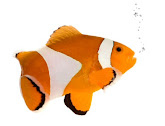How to Raise Brine Shrimp
Brine shrimp are a nutritious and easy to raise feed for tropical and marine aquaria life. They are heavily relied upon as a first food for fry (baby fish) and are used as a diet supplement by many avid fish keepers for their nutritional value, and perhaps also the interest it sparks in their fish! Brine shrimp, particularly in their adult stages, can be bought in most pet stores, but it if often cheaper and more convenient to raise them at home.
Steps
Cut the base off of a soft drink bottle about 1/3 of the way up, this will become the base of your hatchery. With the lid screwed onto the top half, place it upside-down in the base.
Dissolve 1 dessert spoon of sea salt in a small amount of lukewarm water. Pour this into your hatchery and top up with tap water (dechlorinater is not necessary).
Place an air stone into the bottom of the hatchery and turn the air pump on. Add half a teaspoon of brine shrimp eggs to the hatchery. If possible, leave your hatchery in a warm place, preferably out of direct sunlight. Your brine shrimp should begin to hatch after 12 hours and continue to do so for up to 26 (hatching times will vary depending on the eggs you use, water temperature and salinity).
Notice that your brine shrimp are extremely tiny, smaller than a pins head. At this stage they are suitable to feed to young fry. Harvest them by siphoning with airline tubing, or by slightly loosening the cap on the bottom of the hatchery over a handkerchief. Rinse in fresh water for a few seconds and feed to your fry.
To grow your brine shrimp onto adulthood, you will need to feed them. For the first 24 hours of life your brine shrimp will not require feeding as they are still relying on their egg sac, and have not fully developed their digestive system. Brine shrimp are non-selective filter feeders (meaning they're not fussy) and can be fed with a wide range of foods, including but not limited to Liquidfry or similar fry food, yeast, whey, wheat flour, soybean powder, fish meal and egg yolk. The criteria for suitable foods is small, easily digestible particles which do not dissolve in water ( eg. powdered milk won't work). Most important of all, do not overfeed your brine shrimp! In the small capacity of the soft drink bottle, it is very easy to foul up the water with excess feeding.
You may find it necessary to change the water in the hatchery. An easy way to do this without losing any of your tiny brine shrimp is to siphon the water out through an airstone. Replace the siphoned water with adequately salty water (just make a guess based on how much salt you originally put in, in comparison to how much water you took out - remember too much salt is better than too little.
Depending on water conditions, foods and the strain of brine shrimp you are raising, it could take anywhere from a week or so to a month to reach adult size. How long, or more accurately, to what size you raise your brine shrimp to is up to you.
Tips
Measurements will need to be adjusted for the materials available in your area, and the scale at which you wish to conduct your hatching operation. All values need only be approximates.
A soft drink bottle is usually preferred over other containers, such as an ice-cream container, because of it's rounded shape and removable base (the cap). Brine shrimp need rapid aeration for both air and reaching food, and will tend to get stuck in the corners of a rectangular container, especially if there is a a light source near by. However, if the drink bottle doesn't work for you, experiment with other containers until you find something that does (and add your knowledge to this article!)
Brine shrimp are attracted to light. Using a torch to attract them into one area can greatly aid in catching them. Without a strong light-source and in the absence of water agitation, brine shrimp naturally sink, whilst their hatched eggshells float, therefore the removable base of the soft drink hatchery makes harvesting easier.
Experiment with different methods of hatching and raising your brine shrimp and use what works best for you.
Warnings
Be very careful when working with both water and electricity. Although air pumps are built to be used around water, they vary in quality and are not built to be submerged or doused in water.
Things You'll Need
2 liter soft drink bottle or similar
Brine shrimp eggs (available in many pet shops, online stores and auction sites)
Sea, aquarium or kosher salt (not regular table salt, as it contains additives)
Air stone, tubing and small air pump



